| A brief history of Bingen | 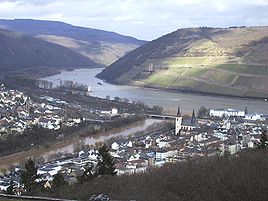 |
|
Bingen on the Rhine |
| The history of Bingen – also known as the gateway to the Middle Rhine – goes way back to the days before the Romans, shown by the number of Celtic objects that have been found. | |

Alt-Bingen nach Merian um 1650 |
The meaning of the name Bingen is still not clear, in spite of enormous
effort that has been made to find its origin, but it seems that the name is
neither Germanic nor Roman, but Celtic. Very early on Bingen had a Christian congregation. That is proven by the gravestone of the priest, Aetherius, presumably from 400 AD, and it is close to the Roman graves. |
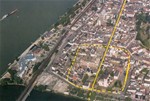
|
The Romans built the Castell Bingium (Bingium Castle) at the junction of the
rivers Rhine and Nahe, due to the favourable location. It is in Bingen that the
Roman road from Mainz splits up. One part leads downriver to Koblenz, the other
part leads over the Hunsrück to Trier. A former Roman bridge was found near the
culture centre, and the bridge was built in 77AD.
On 14 June 983, Kaiser Otto II at the imperial gathering in Verona – at that time Bingen belonged to Italy – out of gratitude granted supremacy to the chancellor, Archbishop Willigis in Mainz, over the town of Bingen and the surrounding countryside. This gift is also known as the imperial act in Verona. |
| Das spätantike castrum ist im heutigen Straßenverlauf der Innenstadt noch ablesbar |
After the Second World War there was the historical beginning of the partnership
between the province of Verona and the Mainz-Bingen district, which includes the
two towns of Bingen and Verona.
In 996 Otto II added to this gift a part of the imperial forest in Hunsrück,
nowadays called the Bingen Wood.
During the conflict between the papacy and the empire there was a significant
date: on Christmas Eve in 1105 Emperor Heinrich IV was incarcerated in Burg
Klopp (Klopp Castle) by his son, Heinrich V, in order to force him to abdicate.
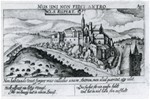
|
In 1147 the Rupertsberg convent was founded by Hildegard von Bingen. This
fascinating person in the Middle Ages was highly regarded as a mystic, nature
researcher, doctor and teacher. During the imperial epoch Bingen was part of a large organisation of towns. Its armed forces always joined in the fight against robbers on the river and on land, and helped to secure peace in the region. In the customs war in 1301, King Albrecht I laid siege on Bingen and captured the town, and Burg Klopp was destroyed. In 1424, as the result of an agreement, Bingen was transferred to the cathedral chapter in Mainz.
In 1147 the Rupertsberg convent was founded by Hildegard von Bingen. This
fascinating person in the Middle Ages was highly regarded as a mystic, nature
researcher, doctor and teacher. |
| Kloster Rupertsberg, Bingen |
During the imperial epoch Bingen was part of a large organisation of towns. Its armed forces always joined in the fight against robbers on the river and on land, and helped to secure peace in the region.

|
In 1403 and 1490 Bingen was almost destroyed by fire. In the 30-year war the
town was badly damaged. The soldiers of Ludwig XIV also set the town on fire. In
the 18th century war enveloped Bingen again. In the 19th and 20th centuries
Bingen was part of the grand duchy and later part of the state of Hesse, and
joined in the fate of the German states and later the empire.
The wars in the last 150 years are still painful memories in the old part of the
town. |
| Bingen unmittelbar vor der Zerstörung von 1689 |
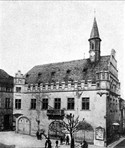
|
As the town grew, it became seven suburbs, In 1969 Bingen was granted the
status of a district town. The town has around 25,000 inhabitants. For centuries in Bingen there has been winegrowing and the wine trade. Some well-known vineyards, such as Scharlachberg, Schwätzerchen, Bubenstück and St Rochuskapelle, have a reputation at home and abroad for top quality. The drinks industry in Bingen is an important economic factor. This development has led to the establishment of environmentally friendly industries. At home in Bingen is a large European company that produces play machines, music boxes and other entertainment devices. A large firm supplies tableware of high quality for healthy living. Alongside the large firms there are various and sound middle-sized firms. |
| Das alte Binger Rathaus |
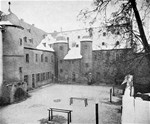
|
As the European motorway network developed, Bingen became a key hub, and in
the last few years has concentrated on providing residential areas and
industrial sites. In addition to the optimum road and rail connections the Rhein-Main
airport, the German and international shipping lines should not be forgotten. In the town of Bingen tourism has a long tradition. The town is very popular as a excursion destination and a holiday town. The leisure-time activities are valuable assets. |
| Das Amtshaus |
In the heart of the town there are the Höhenpark Rochusberg, a
forest teaching path and a keep-fit path. There is also the swimming pool high
above the town with a magnificent view over the Rhine, which is an additional
attraction. The Bingen Wood covers an area of 2,000 hectares, and it is a
popular place for the people who live in the town and for visitors from Germany,
from abroad and those living in the Rhein-Main region. The enjoyable circular
rambling paths are well signposted. The Binge Winzerfest (vintners’ festival),
which takes place on the first weekend in September, attracts thousands of
visitors. The pilgrimage to St Rochus, that takes place on 16 August, is also
well-known beyond the borders of the town.
There are partnerships with Prizren in Kosovo, in the former Yugoslavia, Hitchin
in England, Nuits-Saint-Georges and Venarey-les-Laumes in France. And there is
the friendly relationship with the province of Verona in Italy.
Bingen is also an education centre, with primary schools, secondary-modern
schools, a state secondary school, grammar schools and vocational schools, and
technical college, all of which demonstrate the wide variety of education on
offer in the educational establishments. The Volkshochschule (night school) is
particularly worth mentioning, as well as the music school and places of further
education in and around the town. In the sport centre in Büdesheim, part of the
town, in the last few years sport facilities, indoor tennis courts and a
circular sport hall with an international playing area and an indoor swimming
pool have been created.
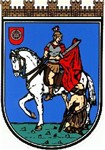 Through the
development of the pedestrian precinct, which has a length of about 1,000 metres,
the urban character of the town has been promoted. Attractive shops invite you
to a cosy shopping spree.
Through the
development of the pedestrian precinct, which has a length of about 1,000 metres,
the urban character of the town has been promoted. Attractive shops invite you
to a cosy shopping spree.
The town of Bingen has grown on historical ground, but has remained young and
full of dynamism. It functions as a middle-sized centre and the catchment area
contains 50,000 people.
The above was found on a German tourism site http://www.bingen.de/en/2/touristinformation_070223_stadtgeschichte.html